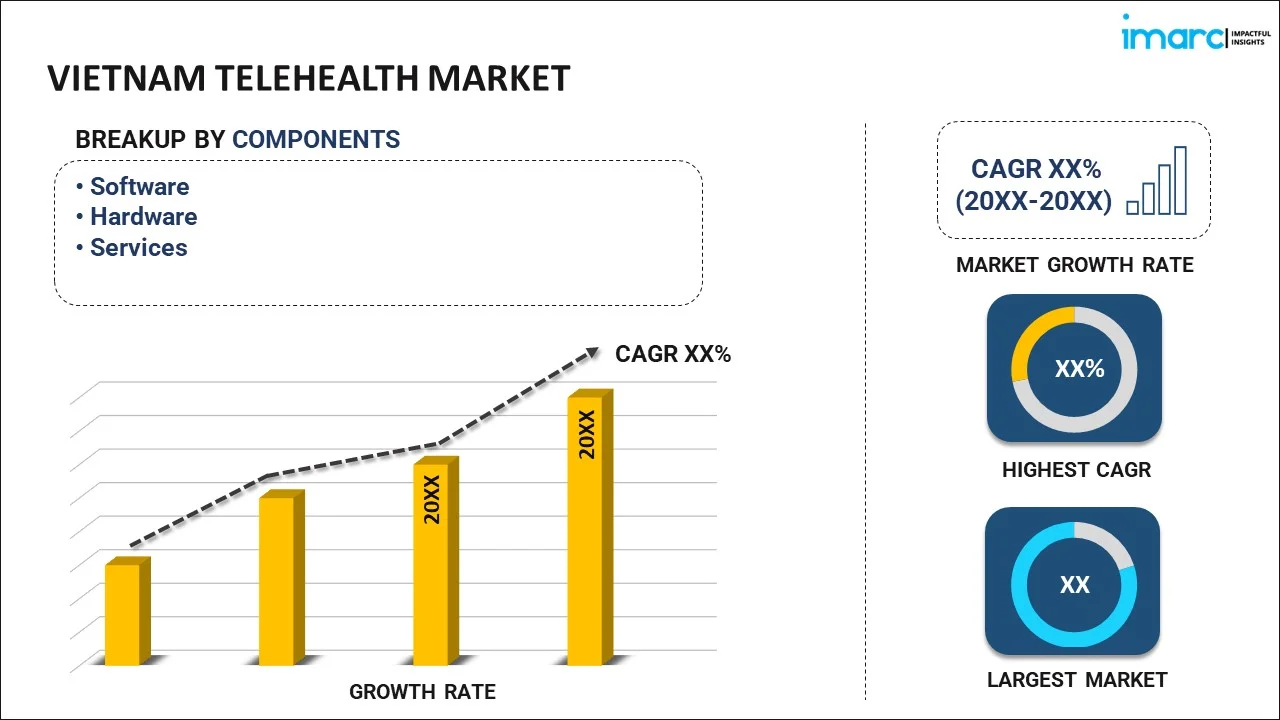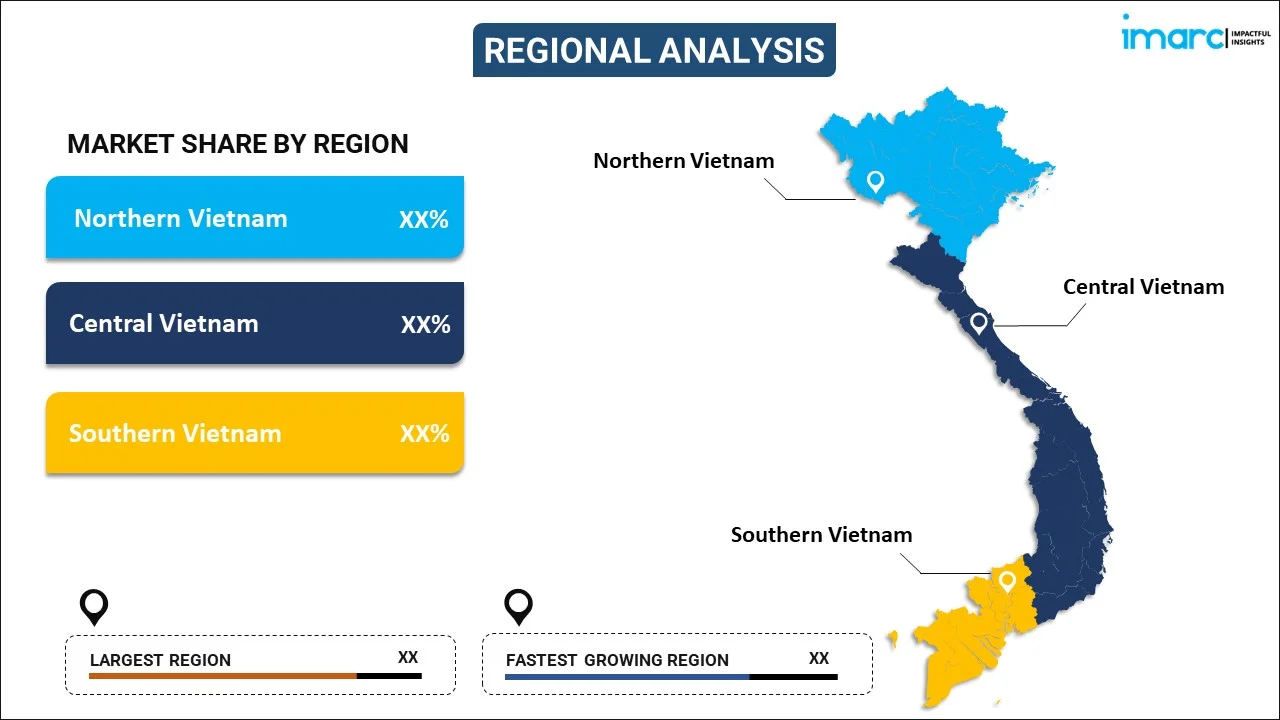
Vietnam Telehealth Market Report by Component (Software, Hardware, Services), Communication Technology (Video Conferencing, mHealth Solutions, and Others), Hosting Type (Cloud-Based and Web-based, On-Premises), Application (Teleconsultation and Telementoring, Medical Education and Training, Teleradiology, Telecardiology, Tele-ICU, Tele-Psychiatry, Tele-Dermatology, and Others), End User (Providers, Patients, Payers, and Others), and Region 2024-2032
Market Overview:
Vietnam telehealth market size is projected to exhibit a growth rate (CAGR) of 21.85% during 2024-2032. The increasing advancements in communication technology, including high-speed internet, smartphones, wearable devices, and remote monitoring tools, which help to access healthcare services from the comfort of home, are driving the market.
|
Report Attribute
|
Key Statistics
|
|---|---|
|
Base Year
|
2023 |
|
Forecast Years
|
2024-2032
|
|
Historical Years
|
2018-2023
|
| Market Growth Rate (2024-2032) | 21.85% |
Telehealth refers to the provision of healthcare services remotely using telecommunications technology. It allows patients to consult with healthcare professionals, receive medical advice, and even undergo certain diagnostic and treatment procedures without the need for in-person visits. Telehealth encompasses a wide range of services, including video conferencing, phone calls, text messaging, and secure online platforms. Telehealth has gained significant importance, as it minimizes physical contact and helps maintain social distancing while ensuring continued access to healthcare. Patients can seek medical guidance from the comfort of their homes, which is especially beneficial for individuals with mobility issues, those in rural or underserved areas, or those facing transportation barriers. Telehealth has expanded access to healthcare services, improved convenience, and reduced healthcare costs. To maximize its benefits, healthcare providers and policymakers continue to work on improving telehealth infrastructure, regulations, and integration into mainstream healthcare delivery.
Vietnam Telehealth Market Trends:
The telehealth market in Vietnam is experiencing unprecedented growth, primarily due to several key drivers that have reshaped the healthcare landscape. Firstly, advancements in technology have played a pivotal role in fostering the adoption of telehealth solutions. With the proliferation of smartphones, high-speed internet access, and wearable devices, patients can easily connect with healthcare providers from the comfort of their homes. Furthermore, the need to reduce in-person visits to healthcare facilities has prompted both patients and healthcare providers to embrace telehealth services as a safe and convenient alternative. In addition to this, the increasing focus on cost-effective healthcare delivery is a significant driver. Telehealth offers potential cost savings by reducing the need for physical infrastructure and minimizing travel expenses for patients. This has attracted the attention of healthcare organizations, payers, and governments alike as they seek ways to control healthcare expenditures. Moreover, the growing aging population and the rise in chronic diseases have created a higher demand for healthcare services. Telehealth enables timely access to care, particularly for those in remote or underserved areas, addressing the need for expanded healthcare access. This, in turn, is expected to drive the market in Vietnam during the forecast period.
Vietnam Telehealth Market Segmentation:
IMARC Group provides an analysis of the key trends in each segment of the market, along with forecasts at the country level for 2024-2032. Our report has categorized the market based on component, communication technology, hosting type, application, and end user.
Component Insights:

- Software
- Hardware
- Services
The report has provided a detailed breakup and analysis of the market based on the component. This includes software, hardware, and services.
Communication Technology Insights:
- Video Conferencing
- mHealth Solutions
- Others
A detailed breakup and analysis of the market based on the communication technology have also been provided in the report. This includes video conferencing, mhealth solutions, and others.
Hosting Type Insights:
- Cloud-Based and Web-based
- On-Premises
The report has provided a detailed breakup and analysis of the market based on the hosting type. This includes cloud-based and web-based and on-premises.
Application Insights:
- Teleconsultation and Telementoring
- Medical Education and Training
- Teleradiology
- Telecardiology
- Tele-ICU
- Tele-Psychiatry
- Tele-Dermatology
- Others
A detailed breakup and analysis of the market based on the application have also been provided in the report. This includes teleconsultation and telementoring, medical education and training, teleradiology, telecardiology, tele-ICU, tele-psychiatry, tele-dermatology, and others.
End User Insights:
- Providers
- Patients
- Payers
- Others
The report has provided a detailed breakup and analysis of the market based on the end user. This includes providers, patients, payers, and others.
Regional Insights:

- Northern Vietnam
- Central Vietnam
- Southern Vietnam
The report has also provided a comprehensive analysis of all the major regional markets, which include Northern Vietnam, Central Vietnam, and Southern Vietnam.
Competitive Landscape:
The market research report has also provided a comprehensive analysis of the competitive landscape in the market. Competitive analysis such as market structure, key player positioning, top winning strategies, competitive dashboard, and company evaluation quadrant has been covered in the report. Also, detailed profiles of all major companies have been provided.
Vietnam Telehealth Market Report Coverage:
| Report Features | Details |
|---|---|
| Base Year of the Analysis | 2023 |
| Historical Period | 2018-2023 |
| Forecast Period | 2024-2032 |
| Units | US$ Million |
| Scope of the Report | Exploration of Historical and Forecast Trends, Industry Catalysts and Challenges, Segment-Wise Historical and Predictive Market Assessment:
|
| Components Covered | Software, Hardware, Services |
| Communication Technologies Covered | Video Conferencing, mHealth Solutions, Others |
| Hosting Types Covered | Cloud-Based and Web-based, On-Premises |
| Applications Covered | Teleconsultation and Telementoring, Medical Education and Training, Teleradiology, Telecardiology, Tele-ICU, Tele-Psychiatry, Tele-Dermatology, Others |
| End Users Covered | Providers, Patients, Payers, Others |
| Regions Covered | Northern Vietnam, Central Vietnam, Southern Vietnam |
| Customization Scope | 10% Free Customization |
| Report Price and Purchase Option | Single User License: US$ 3699 Five User License: US$ 4699 Corporate License: US$ 5699 |
| Post-Sale Analyst Support | 10-12 Weeks |
| Delivery Format | PDF and Excel through Email (We can also provide the editable version of the report in PPT/Word format on special request) |
Key Questions Answered in This Report:
- How has the Vietnam telehealth market performed so far and how will it perform in the coming years?
- What has been the impact of COVID-19 on the Vietnam telehealth market?
- What is the breakup of the Vietnam telehealth market on the basis of component?
- What is the breakup of the Vietnam telehealth market on the basis of communication technology?
- What is the breakup of the Vietnam telehealth market on the basis of hosting type?
- What is the breakup of the Vietnam telehealth market on the basis of application?
- What is the breakup of the Vietnam telehealth market on the basis of end user?
- What are the various stages in the value chain of the Vietnam telehealth market?
- What are the key driving factors and challenges in the Vietnam telehealth?
- What is the structure of the Vietnam telehealth market and who are the key players?
- What is the degree of competition in the Vietnam telehealth market?
Key Benefits for Stakeholders:
- IMARC’s industry report offers a comprehensive quantitative analysis of various market segments, historical and current market trends, market forecasts, and dynamics of the Vietnam telehealth market from 2018-2032.
- The research report provides the latest information on the market drivers, challenges, and opportunities in the Vietnam telehealth market.
- Porter's five forces analysis assist stakeholders in assessing the impact of new entrants, competitive rivalry, supplier power, buyer power, and the threat of substitution. It helps stakeholders to analyze the level of competition within the Vietnam telehealth industry and its attractiveness.
- Competitive landscape allows stakeholders to understand their competitive environment and provides an insight into the current positions of key players in the market.
Need more help?
- Speak to our experienced analysts for insights on the current market scenarios.
- Include additional segments and countries to customize the report as per your requirement.
- Gain an unparalleled competitive advantage in your domain by understanding how to utilize the report and positively impacting your operations and revenue.
- For further assistance, please connect with our analysts.
 Inquire Before Buying
Inquire Before Buying
 Speak to an Analyst
Speak to an Analyst
 Request Brochure
Request Brochure
 Request Customization
Request Customization




.webp)




.webp)












